| Article ID | Journal | Published Year | Pages | File Type |
|---|---|---|---|---|
| 3286359 | Clinics and Research in Hepatology and Gastroenterology | 2014 | 7 Pages |
SummaryBackgroundEsophageal replacement using digestive organs such as the colon, stomach, or jejunum has been used to treat long-gap esophageal atresia and caustic esophageal strictures. Nevertheless, it presents a major challenge. Here, we report a preliminary experimental study that examined the use of a free dilated ureter as an option for esophageal substitution in a transplantation rat model.MethodsTen 28-week-old male donor rats underwent distal ureteral ligation for 4 weeks, and the total dilated ureters were recovered. In each of the ten recipient 20-week-old male rats, a ureter was transplanted through the mediastinum into the esophageal bed, without vascular anastomosis. All rats received cyclosporine and cotrimoxazole for 10 days. On postoperative day 10, the rats were sacrificed, and the transplanted ureters were evaluated macroscopically and histopathologically.ResultsAll procedures were achieved. In the early postoperative period, three transplanted rats died. Upon macroscopic evaluation, no evidence of complications was observed, and all transplanted ureters exhibited apparently good firm tissue. Histopathological examination showed a viable ureteral structure with good vascularity, low inflammation, and regenerated epithelium in all rats.ConclusionAs an option for esophageal substitution, heterotopic ureteral transplantation can be performed directly into the mediastinal location of the esophagus, without vascular anastomosis in a rat model. In the future, free dilated ureters might be useful for esophageal grafting or patching in humans; however, this procedure must be validated in additional large animal models before being attempted in humans.
